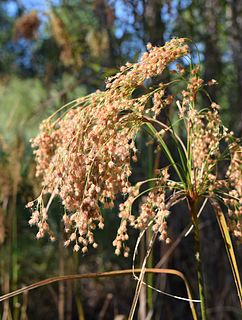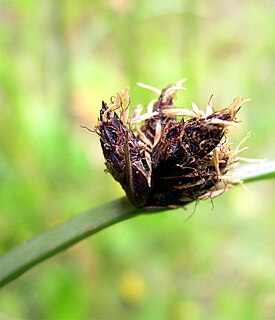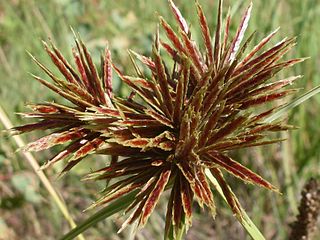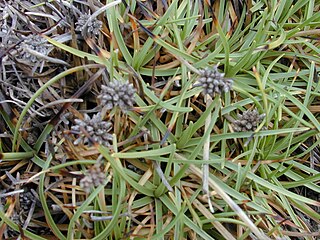
The Cyperaceae are a family of graminoid (grass-like), monocotyledonous flowering plants known as sedges. The family is large, with some 5,500 known species described in about 90 genera, the largest being the "true sedges" genus Carex with over 2,000 species.

Scirpus is a genus of grass-like species in the sedge family Cyperaceae many with the common names club-rush, wood club-rush or bulrush. They mostly inhabit wetlands and damp locations.

Fimbristylis is a genus of sedges. A plant in this genus may be known commonly as a fimbry, fimbristyle, or fringe-rush. There are 200 to 300 species distributed worldwide. Several continents have native species but many species have been introduced to regions where they are not native. Some are considered weeds. These are typical sedges in appearance, with stiff, ridged stems and cone-shaped terminal panicles of spikelets. They are found in wet environments, and are most diverse in tropical and subtropical regions.

Cyperus difformis is a species of sedge known by several common names, including variable flatsedge, smallflower umbrella-sedge and rice sedge. This plant is native to southern Europe, most of Africa and Asia, and Australia, and it is naturalized in other areas of the world, including large parts of the Americas.

Fimbristylis thermalis is a species of fimbry known by the common name hot springs fimbry. It is native to the southwestern United States and northern Mexico. It has been reported from Baja California, California, Arizona, Nevada, Utah and Coahuila.

Scirpus cyperinus, commonly known as woolgrass, is a herbaceous emergent that is native to the eastern United States and eastern Canada. Other common names include cottongrass bulrush and brown woolly sedge.

Schoenoplectus pungens is a species of flowering plant in the sedge family known as common threesquare, common three-square bulrush and sharp club-rush. It is a herbaceous emergent plant that is widespread across much of North and South America as well as Europe, New Zealand and Australia.

Fimbristylis ferruginea is a species of fimbry known by the common names rusty sedge and West Indian fimbry. The plant is common along the coast line and estuaries of Australia. It is also native to parts of Africa, southern Asia, and South America. The flowers are a distinctive rusty brown color appearing on a single spikelet from May to July.
Fimbristylis polytrichoides is a species of fimbry known by the common name rusty sedge, native to east Africa, Madagascar, China, Southeast Asia, New Guinea and Australia. The plant is common along the coast line and estuaries of Australia. The flowers are a distinctive rusty brown color appearing on a single spikelet from May to July.

Schoenoplectus lacustris, the lakeshore bulrush or common club-rush, is a species of club-rush that grows in fresh water across Europe and some neighbouring areas.

Isolepis prolifera is a species of flowering plant in the family Cyperaceae that grows in temperate regions of the Southern Hemisphere. It has leafless stems up to 90 cm (35 in) tall, and clusters of flowers that often proliferate into branches.

Fimbristylis dichotoma, commonly known as forked fimbry or eight day grass, is a sedge of the family Cyperaceae that is native to tropical areas.

Cyperus congestus, commonly known as dense flat-sedge or clustered flat-sedge, is a sedge of the family Cyperaceae that is native to southern Africa mostly in South Africa, Lesotho and Namibia.

Eleocharis ochrostachys, commonly known as spike rush, is a sedge of the family Cyperaceae that is native to Australia and Asia.
Fimbristylis acicularis is a sedge of the family Cyperaceae that is native to northern and north eastern Australia.
Fimbristylis acuminata, commonly known as pointed fimbristylis, is a sedge of the family Cyperaceae that is found in tropical areas extending from India, through parts of South East Asia and into northern Australia.
Fimbristylis aestivalis commonly known as summer fimbry, is a sedge of the family Cyperaceae that is native to Australia. The specific epithet, aestivalis, is derived from Latin and means "pertaining to the summer".

Fimbristylis castanea, commonly known as marsh fimbry or saltmarsh fimbristylis, is a perennial sedge of the family Cyperaceae that is native to the United States of America.

Fimbristylis cymosa, commonly known as tropical fimbry, or St. John's sedge, is a sedge of the family Cyperaceae that is native to Australia.

Fimbristylis littoralis, commonly known as lesser fimbry or lesser fimbristylis, is a sedge of the family Cyperaceae that is native to many countries in Africa, Asia and Oceania including across much of northern Australia.

















